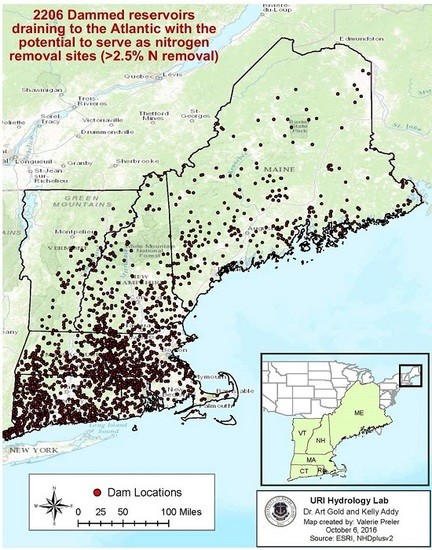Will Dam Removal Increase Nitrogen Flux to Estuaries?
Abstract
:1. Introduction
2. Approach
2.1. Assessing N Removal in Reservoirs
2.2. Assessing Dams and Associated Geospatial Data of Atlantic Watersheds in New England
2.3. Estimating Nitrogen Loading to Dammed Reservoirs
3. Results
4. Discussion
4.1. Strategic vs. Opportunistic Views of N Tradeoff Dams
4.2. Fish Passage Designs to Minimize Tradeoffs between Dams and Connectivity?
4.3. Other Perspective on Tradeoffs for N Removal Dams
Supplementary Materials
Acknowledgments
Author Contributions
Conflicts of Interest
Abbreviations:
| N | Nitrogen |
| D | Depth |
| T | Hydraulic Residence Time |
| V | Reservoir Volume |
| Ar | Reservoir Area |
| Qyear | Discharge from Reservoir |
| Aw | Watershed Area |
| Qnorm | Discharge Normalized by Area |
| HUC | Hydrologic Unit Code |
| ME | Maine |
| NH | New Hampshire |
| MA | Massachusetts |
| VT | Vermont |
| CT | Connecticut |
| RI | Rhode Island |
| NCAT | Northeast Aquatic Connectivity Tool |
References
- Stanley, E.H.; Doyle, M.W. Trading off: The ecological effects of dam removal. Front. Ecol. Environ. 2003, 1, 15–22. [Google Scholar] [CrossRef]
- Doyle, M.W.; Harbor, J.M.; Stanley, E.H. Toward policies and decision-making for dam removal. Environ. Manag. 2003, 31, 453–465. [Google Scholar] [CrossRef] [PubMed]
- Larinier, M. Dams and Fish Migration: World Commission on Dams; FAO Fisheries Technical Paper 419; Food and Agriculture Organization of the United Nations: Roma, Italy, 2000; pp. 45–89. [Google Scholar]
- Humborg, C.; Ittekkot, V.; Cociasu, A.; Bodungen, B.V. Effect of Danube River dam on Black Sea biogeochemistry and ecosystem structure. Nature 1997, 386, 385–388. [Google Scholar] [CrossRef]
- Pringle, C. What is hydrologic connectivity and why is it ecologically important? Hydrol. Process. 2003, 17, 2685–2689. [Google Scholar] [CrossRef]
- Erzini, K. Trends in NE Atlantic landings (southern Portugal): Identifying the relative importance of fisheries and environmental variables. Fish. Oceanogr. 2005, 14, 195–209. [Google Scholar] [CrossRef]
- Poff, N.L.; Hart, D.D. How dams vary and why it matters for the emerging science of dam removal. BioScience 2002, 52, 659–668. [Google Scholar] [CrossRef]
- Lejon, A.G.C.; Renöfält, B.M.; Nilsson, C. Conflicts associated with dam removal in Sweden. Ecol. Soc. 2009, 14, 2. [Google Scholar]
- Hart, D.D.; Johnson, T.E.; Bushaw-Newton, K.L.; Horwitz, R.J.; Bednarek, A.T.; Charles, D.F.; Kreeger, D.A.; Velinsky, D.J. Dam removal: Challenges and opportunities for ecological research and river restoration. BioScience 2002, 52, 669–682. [Google Scholar] [CrossRef]
- Howarth, R.W.; Anderson, D.M.; Church, T.M.; Greening, H.; Hopkinson, C.S.; Huber, W.C.; Marcus, N.; Naiman, R.J.; Segerson, K.; Sharpley, A.; et al. Clean Coastal Waters: Understanding and Reducing the Effects of Nutrient Pollution; National Academy Press: Washington, DC, USA, 2000. [Google Scholar]
- Nixon, S.W.; Buckley, B.; Granger, S.; Bintz, J. Responses of a very shallow marine ecosystem to nutrient enrichment. Hum. Ecol. Risk Assess. 2001, 7, 1457–1481. [Google Scholar] [CrossRef]
- Oviatt, C.A.; Gold, A.J.; Addiscott, T.M. Nitrate in coastal waters. In Nitrate, Agriculture, and the Environment; Addiscott, T.M., Ed.; Oxford University Press: New York, NY, USA, 2005; pp. 127–147. [Google Scholar]
- Howarth, R.W.; Billen, G.; Swaney, D.; Townsend, A.; Jaworski, N.; Lajtha, K.; Downing, J.A.; Elmgren, R.; Caraco, N.; Jordan, T.; et al. Regional nitrogen budgets and riverine N and P fluxes for the drainages to the North Atlantic Ocean: Natural and human influences. Biogeochemistry 1996, 35, 75–139. [Google Scholar] [CrossRef]
- Jordan, T.E.; Correll, D.L.; Weller, D.E. Effects of agriculture on discharge of nutrients from coastal plain watersheds of Chesapeake Bay. J. Environ. Qual. 1997, 26, 836–848. [Google Scholar] [CrossRef]
- Saunders, D.L.; Kalff, J. Nitrogen retention in wetlands, lakes and rivers. Hydrobiologia 2001, 443, 205–212. [Google Scholar] [CrossRef]
- Boyer, E.W.; Alexander, R.B.; Parton, W.J.; Li, C.; Butterbach-Bahl, K.; Donner, S.D.; Skaggs, R.W.; Del Grosso, S.J. Modeling denitrification in terrestrial and aquatic ecosystems at regional scales. Ecol. Appl. 2006, 16, 2123–2142. [Google Scholar] [CrossRef]
- Seitzinger, S.P.; Styles, R.V.; Boyer, E.W.; Alexander, R.B.; Billen, G.; Howarth, R.W.; Mayer, B.; Van Breemen, N. Nitrogen retention in rivers: Model development and application to watersheds in the northeastern USA. Biogeochemistry 2002, 57, 199–273. [Google Scholar] [CrossRef]
- David, M.B.; Wall, L.G.; Royer, T.V.; Tank, J.L. Denitrification and the nitrogen budget of a reservoir in an agricultural landscape. Ecol. Appl. 2006, 16, 2177–2190. [Google Scholar] [CrossRef]
- Bosch, N.S.; Allan, J.D. The influence of impoundments on nutrient budgets in two catchments of Southeastern Michigan. Biogeochemistry 2008, 87, 325–338. [Google Scholar] [CrossRef]
- Harrison, J.A.; Maranger, R.J.; Alexander, R.B.; Giblin, A.E.; Jacinthe, P.A.; Mayorga, E.; Seitzinger, S.P.; Sobota, D.J.; Wollheim, W.M. The regional and global significance of nitrogen removal in lakes and reservoirs. Biogeochemistry 2009, 93, 143–157. [Google Scholar] [CrossRef]
- Lazar, J.G.; Addy, K.; Gold, A.J.; Groffman, P.M.; McKinney, R.A.; Kellogg, D.Q. Beaver ponds: Resurgent nitrogen sinks for rural watersheds in the Northeast U.S.A. J. Environ. Qual. 2015, 44, 1684–1693. [Google Scholar] [CrossRef] [PubMed]
- Wolheim, W.M.; Vorosmarty, C.J.; Peterson, B.J.; Seitzinger, S.P.; Hopkinson, C.S. Relationship between river size and nutrient removal. Geophys. Res. Lett. 2006, 33, L06410. [Google Scholar] [CrossRef]
- Peterson, B.J.; Wollheim, W.M.; Mulholland, P.J.; Webster, J.R.; Meyer, J.L.; Tank, J.L.; Martí, E.; Bowden, W.B.; Valett, H.M.; Hershey, A.E.; et al. Control of nitrogen export from watersheds by headwater streams. Science 2001, 292, 86–90. [Google Scholar] [CrossRef] [PubMed]
- Tank, J.L.; Rosi-Marshall, E.J.; Baker, M.A.; Hall, R.O. Are rivers just big streams? A pulse method to quantify nitrogen demand in a large river. Ecology 2008, 89, 2935–2945. [Google Scholar] [CrossRef] [PubMed]
- Kellogg, D.Q.; Gold, A.J.; Cox, S.; Addy, K.; August, P.V. A geospatial approach for assessing denitrification sinks within lower-order catchments. Ecol. Eng. 2010, 36, 1596–1606. [Google Scholar] [CrossRef]
- United States Geological Survey (USGS). Water Data for the Nation. 2015. Available online: http://waterdata.usgs.gov/nwis/ (accessed on 20 December 2015). [Google Scholar]
- Armstrong, D.S.; Parker, G.W.; Richards, T.A. Characteristics and Classification of Least Altered Streamflows in Massachusetts; U.S. Geological Survey Scientific Investigations Report 2007-5291; U.S. Geological Survey: Reston, VA, USA, 2008; p. 64. Available online: http://pubs.usgs.gov/sir/2007/5291 (accessed on 27 June 2016).
- Allen, P.M.; Arnold, J.C.; Byars, B.W. Downstream channel geometry for use in planning-level models. J. Am. Water Res. Assoc. 1994, 30, 663–671. [Google Scholar] [CrossRef]
- Schulze, K.; Hunger, M.; Döll, P. Simulating river flow velocity on global scale. Adv. Geosci. 2005, 5, 133–136. [Google Scholar] [CrossRef]
- Environmental Systems Research Institute (ESRI). ArcGIS Desktop: Release 10; Environmental Systems Research Institute: Redlands, CA, USA, 2011. [Google Scholar]
- Graf, W.L. Dam nation: A geographic census of American dams and their large-scale hydrologic impacts. Water Resour. Res. 1999, 35, 1305–1311. [Google Scholar] [CrossRef]
- Rhode Island Geographic Information System (RIGIS). Rhode Island Dams; Environmental Data Center, University of Rhode Island: Kingston, RI, USA, 2001; Available online: http://www.rigis.org/data/dams (accessed on 15 December 2015).
- MassGIS. Massachusetts Dams; The Massachusetts Office of Dam Safety: West Boylston, MA, USA, 2012. Available online: http://www.mass.gov/anf/research-and-tech/it-serv-and-support/applicationserv/office-of-geographic-information-massgis/datalayers/dams.html (accessed on 15 December 2015).
- Connecticut Department of Energy & Environmental Protection (CT DEEP). Connecticut Dams; CT DEEP: Hartford, CT, USA, 1996. Available online: http://www.ct.gov/deep/cwp/view.asp?a=2698&q=322898&deepNav_GID=1707 (accessed on 15 December 2015).
- New Hampshire Granit (NH GRANIT). New Hampshire Dam Inventory; New Hampshire’s Statewide GIS Clearinghouse: Durham, NH, USA, 2015; Available online: http://www.granit.unh.edu/data/search?dset=damsnh (accessed on 15 December 2015).
- Vermont Center for Geographic Information (VCGI). Vermont Dam Inventory; Department of Environmental Conservation: Montpelier, VT, USA, 2009. Available online: http://vcgi.vermont.gov/opendata (accessed on 15 December 2015).
- Maine Office of GIS (MEGIS). Maine Impoundments and Dams; Maine Department of Environmental Protection: Augusta, ME, USA, 2006. Available online: http://www.maine.gov/megis/catalog/ (accessed on 15 December 2015).
- United States Department of Agriculture (USDA). 8 Digit Watershed Boundary Dataset; USDA/NRCS—National Geospatial Management Center: Reston, VA, USA, 2013. Available online: https://gdg.sc.egov.usda.gov/GDGOrder.aspx (accessed on 10 May 2016).
- Homer, C.G.; Dewitz, J.A.; Yang, L.; Jin, S.; Danielson, P.; Xian, G.; Coulston, J.; Herold, N.D.; Wickham, J.D.; Megown, K. Completion of the 2011 National Land Cover Database for the conterminous United States-Representing a decade of land cover change information. Photogramm. Eng. Remote Sens. 2015, 81, 345–354. Available online: http://www.mrlc.gov/nlcd2011.php (accessed on 18 March 2016). [Google Scholar]
- Martin, E.H.; Apse, C.D. Northeast Aquatic Connectivity: An Assessment of Dams on Northeastern Rivers; Eastern Freshwater Program; The Nature Conservancy: Bruswick, ME, USA, 2011; Available online: http://rcngrants.org/content/northeast-aquatic-connectivity (accessed on 24 May 2016).
- Environmental Protection Agency (EPA). Geospatical Data Access Project. Available online: https://www.epa.gov/enviro/geospatial-data-download-service (accessed on 21 August 2016).
- Stickney, M.; Hickey, C.; Hoerr, R. Lake Champlain basin program: Working together today for tomorrow. Lakes Reserv. Res. Manag. 2001, 6, 217–223. [Google Scholar] [CrossRef]
- Latimer, J.S.; Charpentier, M.A. Nitrogen inputs to seventy-four southern New England estuaries: Application of a watershed nitrogen loading model. Estuar. Coast. Shelf Sci. 2010, 89, 125–136. [Google Scholar] [CrossRef]
- Valiela, I.; Collins, G.; Kremer, J.; Lajtha, K.; Geist, M.; Seely, M.; Brawley, J.; Sham, C.H. Nitrogen loading from coastal watersheds to receiving estuaries: New method and application. Ecol. Appl. 1997, 7, 358–380. [Google Scholar] [CrossRef]
- Law, N.; Band, L.; Grove, M. Nitrogen input from residential lawn care practices in suburban watersheds in Baltimore County, MD. J. Environ. Plan. Manag. 2004, 47, 737–755. [Google Scholar] [CrossRef]
- Ollinger, S.V.; Aber, J.D.; Lovett, G.M.; Millham, S.E.; Lathrop, R.G.; Ellis, J.M. A spatial model of atmospheric deposition for the northeastern US. Ecol. Appl. 1993, 3, 459–472. [Google Scholar] [CrossRef] [PubMed]
- Shaver, E.; Horner, R.; Skupien, J.; May, C.; Ridley, G. Fundamentals of Urban Runoff Management, 2nd ed.; North American Lake Management Association: Madison, WI, USA, 2007; p. 327. [Google Scholar]
- Nixon, S.; Buckley, B.; Granger, S.; Harris, L.; Oxzkowski, A.; Cole, L.; Fulweiler, R. Anthropogenic Inputs to Narragansett Bay: A Twenty-Five Year Perspective; Narragansett Bay Commission and RI Sea Grant: Narragansett, RI, USA, 2005; p. 52. [Google Scholar]
- United States Department of Agriculture-Natural Resources Conservation Service (USDA-NRCS). Hydrologic soil-cover complexes, part 630 hydrology. In National Engineering Handbook; Natural Resources Conservation Service: Washington, DC, USA, 2004; p. 20. [Google Scholar]
- Environmental Protection Agency (EPA). Publicly Owned Treatment Works General Permit (POTW GP). Available online: https://www3.epa.gov/region1/npdes/potw-gp.html (accessed on 21–24 August 2016).
- Reed, S.C. Nitrogen Removal in wastewater stabilization ponds. J. Water Pollut. Control Fed. 1985, 57, 39–45. [Google Scholar]
- Seaber, P.R.; Kapinos, F.P.; Knapp, G.L. Hydrologic Unit Maps: U.S. Geological Survey Water Supply Paper 2294; U.S. Geological Survey: Reston, VA, USA, 1987.
- Magilligan, F.J.; Graber, B.E.; Nislow, K.H.; Chipman, J.W.; Sneddon, C.S.; Fox, C.A. River restoration by dam removal: Enhancing connectivity at watershed scales. Elementa 2016, 4, 000108. [Google Scholar] [CrossRef]
- Gold, A.J.; Groffman, P.M.; Addy, K.; Kellogg, D.Q.; Stolt, M.; Rosenblatt, A.E. Landscape attributes as controls on ground water nitrate removal capacity of riparian zones. J. Am. Water Resour. Assoc. 2001, 37, 1457–1464. [Google Scholar] [CrossRef]
- Oakley, S.M.; Gold, A.J.; Oczkowski, A.J. Nitrogen control through decentralized wastewater treatment: Process performance and alternative management strategies. Ecol. Eng. 2010, 36, 1520–1531. [Google Scholar] [CrossRef]
- Ribaudo, M.; Hansen, L.; Livingston, M.; Mosheim, R.; Williamson, J.; Delgado, J. Nitrogen in Agricultural Systems: Implications for Conservation Policy. 2011. Available online: https://ideas.repec.org/p/ags/uersrr/118022.html (accessed on 30 October 2016).
- Newcomer Johnson, T.A.; Kaushal, S.S.; Mayer, P.M.; Smith, R.M.; Sivirichi, G.M. Nutrient retention in restored streams and rivers: A global review and synthesis. Water 2016, 8, 116. [Google Scholar] [CrossRef]
- Ribaudo, M.; Abdalla, C.; Stephenson, K.; Wainger, L. Critical Issues in Implementing Nutrient Trading Programs in the Cheaspeake Bay Watershed; STAC Publication #14-002; STAC Publication: Edgewater, MD, USA, 2013. [Google Scholar]
- Crumpton, W.G.; Stenback, G.A. 2013 Annual Report on Performance of Iowa CREP Wetlands: Monitoring and Evaluation of Wetland Performance; Iowa Department of Agriculture and Land Stewardship: Des Moines, IA, USA, 2013; pp. 1–7.
- Kaufman, Z.; Abler, D.; Shortle, J.; Harper, J.; Hamlett, J.; Feather, P. Agricultural costs of the chesapeake bay total maximum daily load. Environ. Sci. Technol. 2014, 48, 14131–14138. [Google Scholar] [CrossRef] [PubMed]
- Franklin, A.E.; Haro, A.; Castro-Santos, T.; Noreika, J. Evaluation of nature-like and technical fishways for the passage of alewives at two coastal streams in New England. Trans. Am. Fish. Soc. 2012, 141, 624–637. [Google Scholar] [CrossRef]
- Roscoe, D.W.; Hinch, S.G. Effectiveness monitoring of fish passage facilities: Historical trends, geographic patterns and future directions. Fish Fish. 2010, 11, 12–33. [Google Scholar] [CrossRef]
- Bunt, C.M.; Castro-Santos, T.; Haro, A. Performance of fish passage structures at upstream barriers to migration. River Res. Appl. 2012, 28, 457–478. [Google Scholar] [CrossRef]
- Turek, J.; Haro, A.; Towler, B. Federal Interagency Nature-Like Fishway Passage Design Guidelines for Atlantic Coast Diadromous Fishes. 2016. Available online: http://www.habitat.noaa.gov/pdf/Final_Federal_Interagency_Technical_Memorandum_Fish_Passage_Guidelines.pdf (accessed on 30 October 2016). [Google Scholar]
- Katopodis, C. Developing a toolkit for fish passage, ecological flow management and fish habitat works. J. Hydraul. Res. 2005, 45, 451–467. [Google Scholar] [CrossRef]
- Roman, C.T.; Jaworski, N.; Short, F.T.; Findlay, S.; Warren, R.S. Estuaries of the northeastern United States: Habitat and land use signatures. Estuaries 2000, 23, 743–764. [Google Scholar] [CrossRef]
- Anthony, A.; Atwood, J.; August, P.V.; Byron, C.; Cobb, S.; Foster, C.; Fry, C.; Gold, A.; Hagos, K.; Heffner, L.; et al. Coastal lagoons and climate change: Ecological and social ramifications in the US Atlantic and Gulf coast ecosystems. Ecol. Soc. 2009, 14, 8. [Google Scholar]
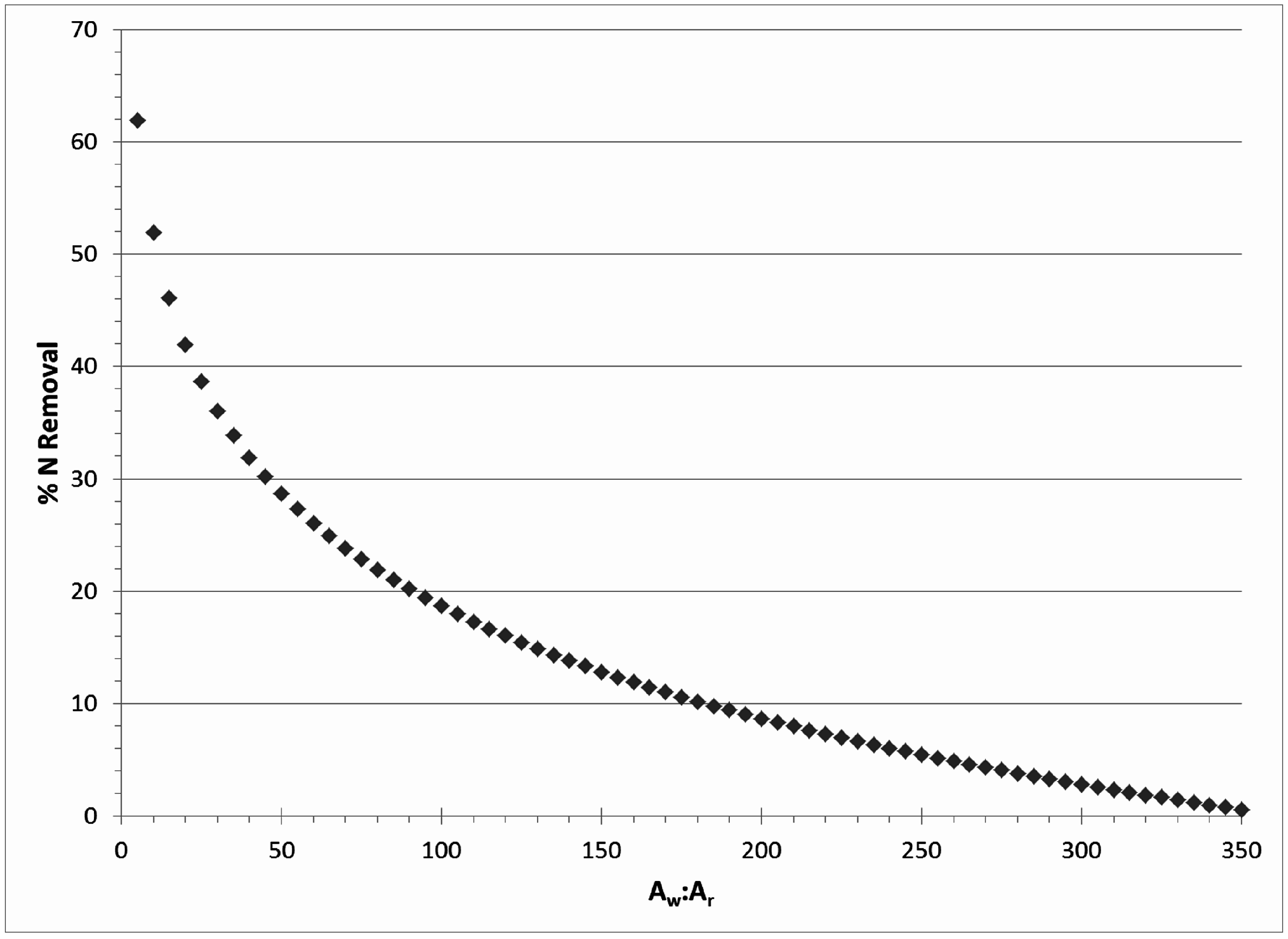
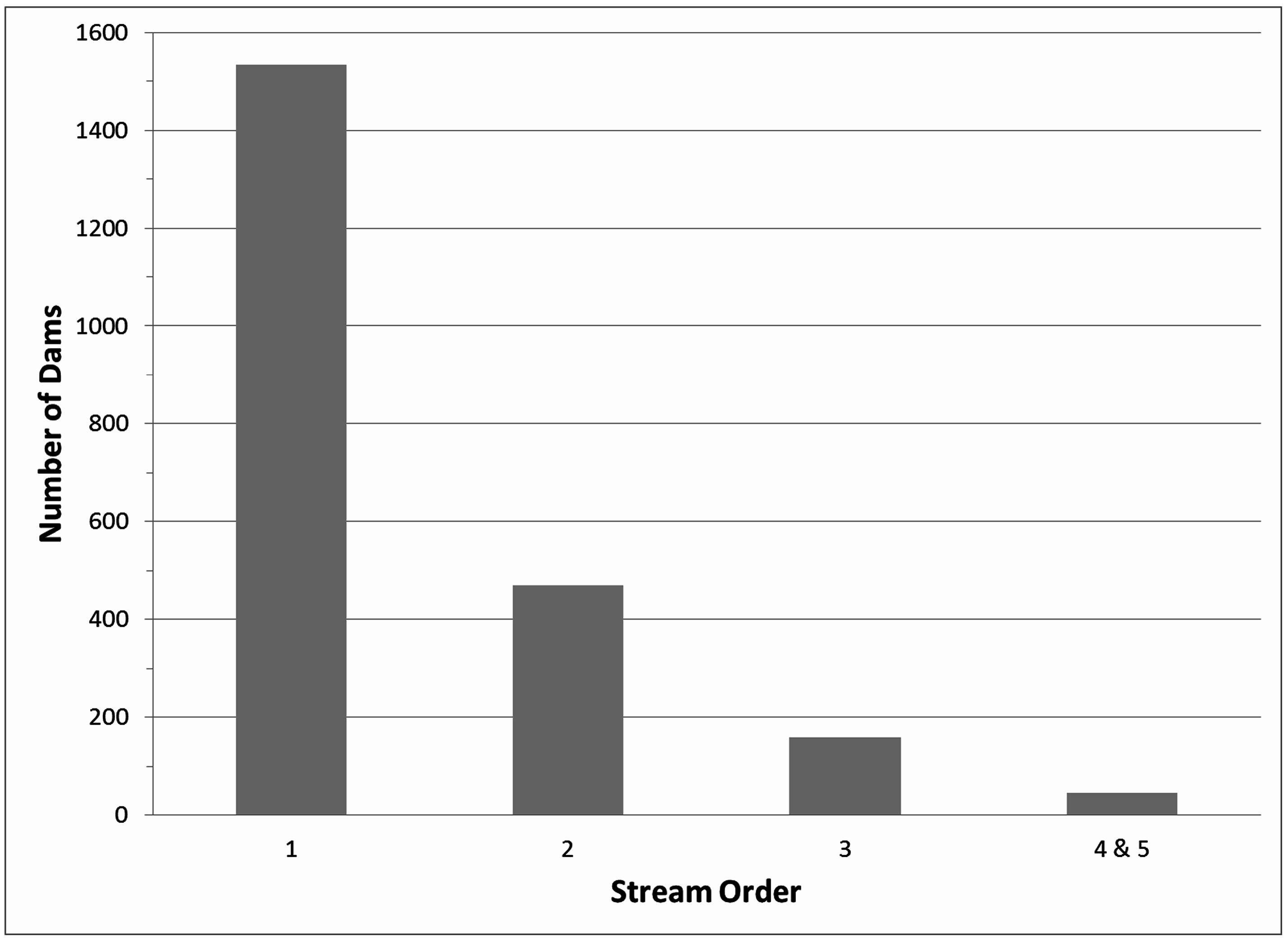
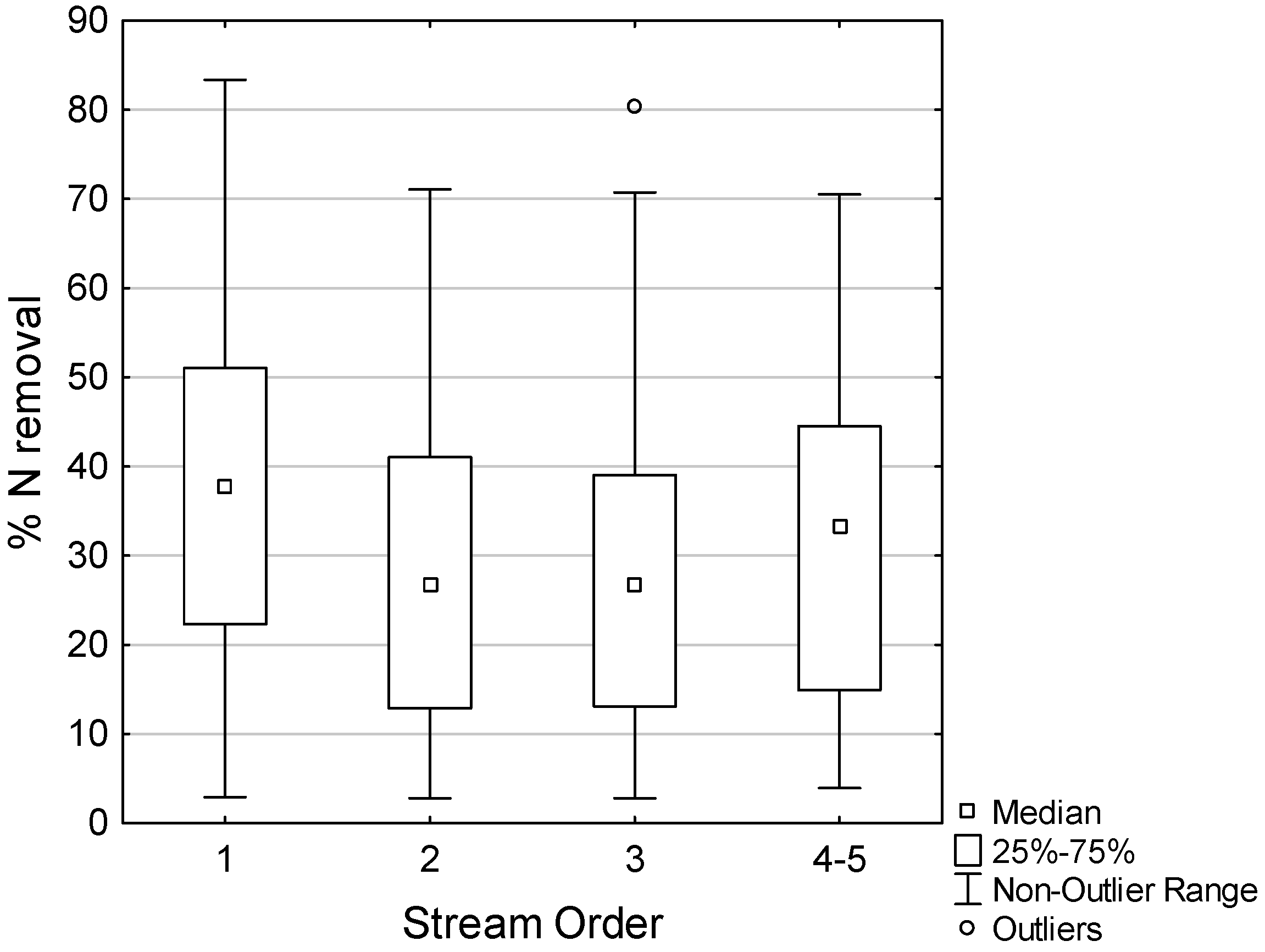
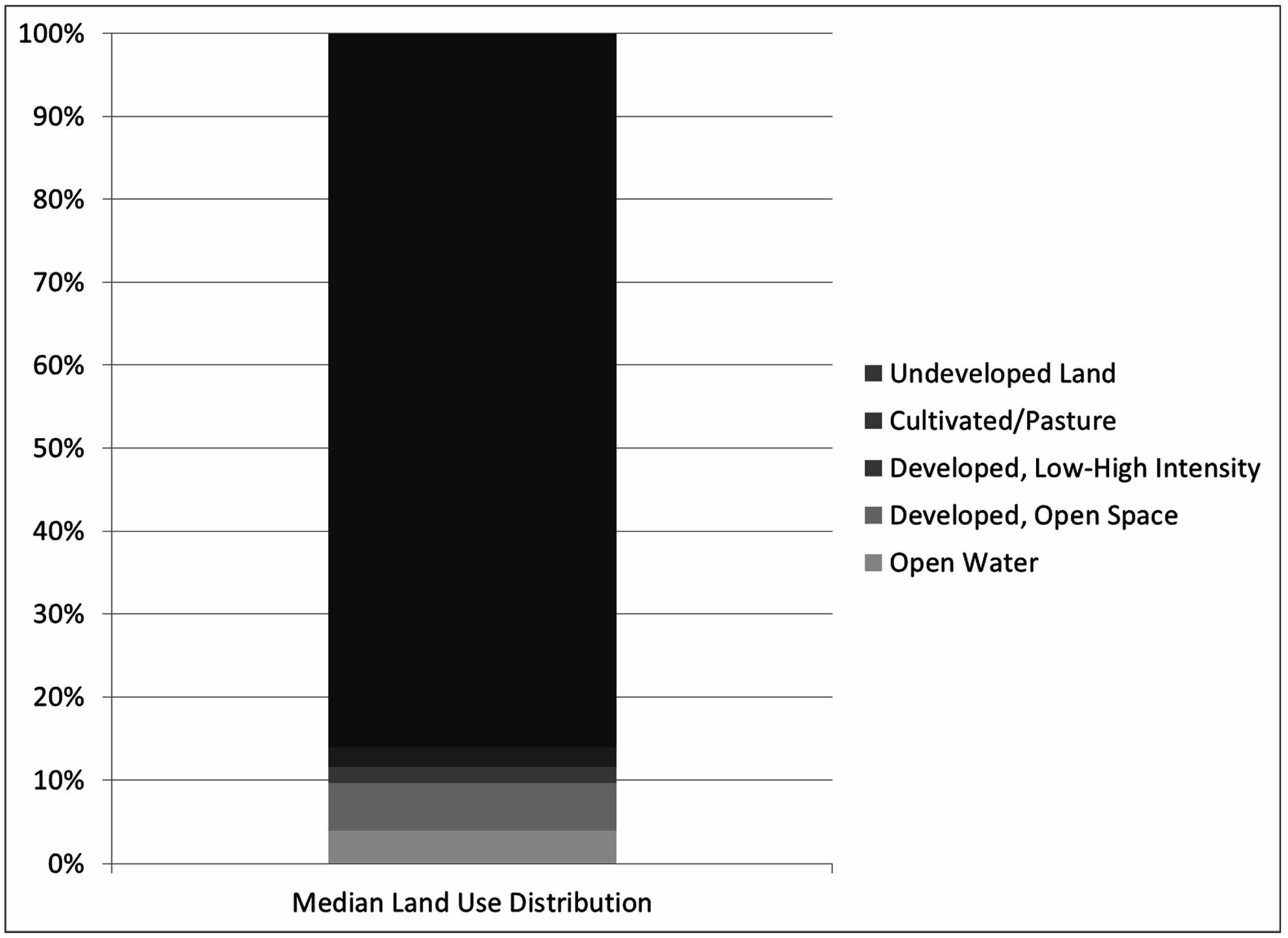
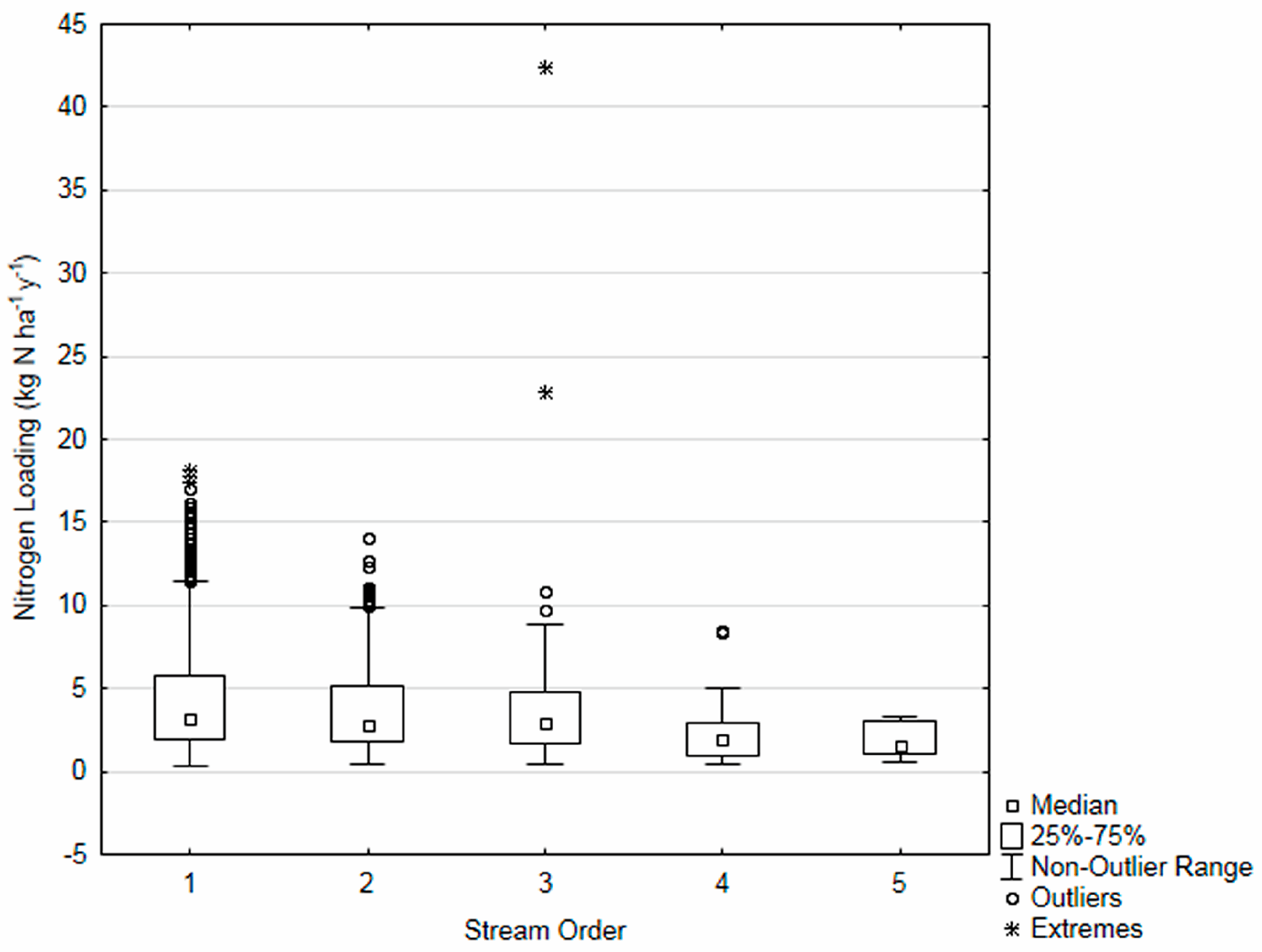
| Data Layer | Source |
|---|---|
| Rhode Island Dams Dataset | Rhode Island Geographic Information System (RIGIS). Available online: http://www.rigis.org/data/dams (accessed on 15 December 2015) [32]. |
| Massachusetts Dams Dataset | The Massachusetts Office of Dam Safety. MassGIS Data. Available online: http://www.mass.gov/anf/research-and-tech/it-serv-and-support/application-serv/office-of-geographic-information-massgis/datalayers/dams.html (accessed on 15 December 2015) [33]. |
| Connecticut Dams Dataset | Connecticut Department of Energy & Environmental Protection. Available online: http://www.ct.gov/deep/cwp/view.asp?a=2698&q=322898&deepNav_GID=1707 (accessed on 15 December 2015) [34]. |
| New Hampshire Dam Inventory | New Hampshire Granit: New Hampshire’s Statewide GIS Clearinghouse. Available online: http://www.granit.unh.edu/data/search?dset=damsnh (accessed on 15 December 2015) [35]. |
| Vermont Dam Inventory | Vermont Center for Geographic Information (VCGI), Department of Environmental Conservation. Available online: http://vcgi.vermont.gov/opendata (accessed on 15 December 2015) [36]. |
| Maine Dam Dataset | Maine Office of Geographic Information Systems (MEGIS). Maine Office of GIS Data Catalog. Maine Impoundments and dams. Available online: http://www.maine.gov/megis/catalog/ (accessed on 15 December 2015) [37] |
| NHDPlusV2 | USGS. Available online: http://waterdata.usgs.gov/nwis/ (accessed on 20 December 2015) [26] |
| HUC-8 WBD | USGS and USDA-NRCS. Geospatial Data Gateway. Available online: https://gdg.sc.egov.usda.gov/GDGOrder.aspx (accessed on 10 May 2016) [38]. |
| NLCD | National Land Cover Database, 2011. Available online: http://www.mrlc.gov/nlcd2011.php (accessed on 18 March 2016) [39]. |
| NCAT | Northeast Aquatic Connectivity. Available online: http://rcngrants.org/content/northeast-aquatic-connectivity (accessed on 24 May 2016) [40]. |
| NPDES | EPA Geospatial Data Access Project. Available online: https://www.epa.gov/enviro/geospatial-data-download-service (accessed on 21 August 2016) [41]. |
| A. Characteristics and Assumptions of Rural Residential Land Use Categories | |||||||
| Land Use [39] | Impervious Surface [39] | Home Density [49] | Lawn Area [45] | Homes That Fertilize [43] | Lawn N Applied [43] | Persons per Home [43] | Septic N Load per Person [43] |
| % | ha−1 | % | % | kg N ha−1·Year−1 | kg N Year−1 | ||
| Developed, Open Space | 10 | 1.2 | 25 | 34 | 104 | 2.4 | 4.8 |
| Developed, Low Intensity | 35 | 9.9 | 15 | 34 | 104 | 2.4 | 4.8 |
| B. Characteristics and Assumptions of Non-Rural Land Use Categories | |||||||
| Land Use [39] | Urban Runoff N Loading [47] | Municipal Wastewater N Loading, Where Applicable [48] | Field N Applied [43] | ||||
| kg N ha−1·Year−1 | |||||||
| Developed, Medium Intensity | 7.0 | 4.1 | - | ||||
| Developed, High Intensity | 11.0 | 4.1 | - | ||||
| Pasture/Cultivated Crops | - | - | 136.0 | ||||
| Summary Statistics | Latimer and Charpentier [43] kg N ha−1·Year−1 | This Study kg N ha−1·Year−1 |
|---|---|---|
| Number of watersheds | 74 | 2206 |
| Minimum | 3.1 | 0.4 |
| 10th percentile | 5.6 | 1.2 |
| 25th percentile | 7.0 | 1.9 |
| Median | 12.0 | 3.0 |
| 75th percentile | 19.0 | 5.5 |
| 90th percentile | 31.0 | 8.5 |
| Maximum | 155.0 | 513.5 |
| Mean | 19.0 | 4.4 |
| Stream Order | # Dams with Safety Concerns † | # Dams with High Priority Fish Habitat ‡ | # Dams with Safety Concerns † or High Priority for Fish Habitat ‡ | # Dams with Safety Concerns † and High Priority for Fish Habitat ‡ | # Dams with Extant Hydropower § |
|---|---|---|---|---|---|
| 1 | 439 (28%) | 43 (3%) | 468 (31%) | 12 (<1%) | 4 (<1%) |
| 2 | 151 (32%) | 51 (11%) | 191 (41%) | 11 (2%) | 7 (1%) |
| 3 | 54 (34%) | 31 (20%) | 77 (49%) | 8 (5%) | 4 (3%) |
| 4 & 5 | 20 (44%) | 13 (29%) | 27 (60%) | 6 (13%) | 6 (13%) |
| Total | 642 | 138 | 763 | 37 | 21 |
| Estuary | USGS HUC α | State(s) | # Dams with Safety Concerns † | # Dams with High Priority Fish Habitat ‡ | # Dams with Safety Concerns † and High Priority for Fish Habitat ‡ | # Dams with Extant Hydropower § |
|---|---|---|---|---|---|---|
| St. John River | 010100 | ME | 1 | 7 | 1 | 0 |
| Penobscot River | 010200 | ME | 4 | 16 | 2 | 1 |
| Kennebec River | 010300 | ME | 16 | 14 | 4 | 1 |
| Androscoggin River | 010400 | ME, NH | 5 | 3 | 1 | 0 |
| Maine Coastal | 010500 | ME | 13 | 40 | 4 | 0 |
| Saco River | 010600 | ME, NH, MA | 25 | 16 | 4 | 0 |
| Merrimack River | 010700 | NH, MA | 76 | 5 | 1 | 8 |
| Connecticut River | 0108 | NH, VT, MA, CT | 166 | 8 | 2 | 2 |
| Charles River | 01090001 | MA | 28 | 5 | 3 | 0 |
| Cape Cod | 01090002 | MA, RI | 29 | 12 | 5 | 0 |
| Blackstone River | 01090003 | MA, RI | 27 | 0 | 0 | 2 |
| Narragansett Bay | 01090004 | MA, RI | 44 | 5 | 4 | 1 |
| Pawcatuck-Wood River | 01090005 | CT, RI | 14 | 1 | 1 | 0 |
| Long Island Sound (excluding Connecticut River) | 0110 | MA, CT, RI | 214 | 8 | 5 | 6 |
© 2016 by the authors; licensee MDPI, Basel, Switzerland. This article is an open access article distributed under the terms and conditions of the Creative Commons Attribution (CC-BY) license (http://creativecommons.org/licenses/by/4.0/).
Share and Cite
Gold, A.J.; Addy, K.; Morrison, A.; Simpson, M. Will Dam Removal Increase Nitrogen Flux to Estuaries? Water 2016, 8, 522. https://doi.org/10.3390/w8110522
Gold AJ, Addy K, Morrison A, Simpson M. Will Dam Removal Increase Nitrogen Flux to Estuaries? Water. 2016; 8(11):522. https://doi.org/10.3390/w8110522
Chicago/Turabian StyleGold, Arthur J., Kelly Addy, Alisa Morrison, and Marissa Simpson. 2016. "Will Dam Removal Increase Nitrogen Flux to Estuaries?" Water 8, no. 11: 522. https://doi.org/10.3390/w8110522
APA StyleGold, A. J., Addy, K., Morrison, A., & Simpson, M. (2016). Will Dam Removal Increase Nitrogen Flux to Estuaries? Water, 8(11), 522. https://doi.org/10.3390/w8110522





